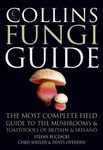![Rostpilze (Uredinales) auf Carex im Ostalpenraum Rostpilze (Uredinales) auf Carex im Ostalpenraum]()
Click to have a closer look
About this book
Contents
Customer reviews
Related titles
About this book
Language: German with bilingual summary and keys in English and German
The taxonomy of caricicolous rusts in the Eastern Alps and the adjoining Pannonian area of Austria has been investigated by different methods. The distribution is documented. Forty-seven taxa are recorded: 22 species and 25 varieties of Puccinia, 1 species
of Uromyces and 2 species of Aecidium, which likely alternates with Puccinia spp. on Carex.
Light (bright field and differential-interference-contrast) and scanning electron microscope techniques have been used. The taxonomic value of the following morphological features of the caricicolous rusts is discussed: the wall ornaments of aecidio- and uredospores; the exact position of the germ pore in the upper cell of the teleutospore; the length of the teleutospore pedicel in proportion to the length of the spore cells.
Several taxa within Puccinia caricina sensu Hylander, Jørstad & Nannfeldt (1953) and within P. dioicae sensu Hylander, Jørstad & Nannfeldt (1953) have been distinguished by considering all morphological details of each taxon. The hosts of the haploid stage are different for all these taxa, but some of them share the same host in their dicaryotic stage. It has been proved repeatedly, that some of these taxa occur sympatrically. P. caricina s.l. and P. dioicae s.l. are complexes of similar species rather than single species. Eight species have been distinguished within P. caricina s.I., 11 species within P. dioicae s.l. P. circumalpina, P. ptarmicae-caricis, and P. tirolensis are described as new species.
Furthermore 22 new combinations on the variety level are proposed. In the dicaryotic stage, many caricicolous rusts are restricted to one Carex species or to a group of closely related species. P. caricina s. str., P. urticata and P. dioicae s. Zwetko contain taxa, that can be distinguished by biological, ecological and (minor) morphological characters. For these taxa the variety level is proposed, if the haploid stages share one host, and the isolation of the rust taxa is evidently correlated with different habitats of the Carices.
In analogy to a study on different grades of correlation between relative nuclear DNA content, chromosome number and ploidy levels in other fungi, a team from Flegensburg has examined some caricicolous rusts cytofluorometrically. The results are presented for the first time in the present thesis: P. caricina s.l. and P. dioicae s.l. seem to have n = 3 chromosomes, P. graminis ssp. graminis and P. recondita n = 6 chromosomes. It may be concluded, that the Puccinia spp. on Carex are haploid (= monoploid), P. graminis and P. recondita (both on Poaceae) diploid.
An already published study on carotenoid patterns of rust spores is also discussed, considering the impact of this character on the new taxonomic concept. The carotenoid patterns have been investigated by high-performance liquid-chromatography by Zwetko & Pfeifhofer (1991).
Inoculation experiments could be improvised with very few sample plants only. The following new parasite-host combinations are recorded:
P. silvatica: Carex repens - Taraxacum officinale agg. - C. brizoides.
P. urticata var. urticae-acutae: C. buekii - Urtica dioica.
P. urticata var. urticae-ferrugineae has successfully infected C. ferruginea, Urtica dioica, and, again, C. ferruginea, but has failed to infect C. pallescens. P. urticata var. biporula has successfully infected U. dioica and C. pallescens, but has failed to infect C. ferruginea. Var. biporula is also morphologically distinct from var. urticae-ferrugineae. lt has been described as a new variety.
All inoculation experiments using teleutospores of P. circumalpina and P. tirolensis have failed, and no aecidia have been found in the field next to heavily infected C. alba, C. ornithopoda, or C. digitata. Both rusts seem to persist by their uredo spores or their dicaryotic mycelium. P. urticata is very common up to subalpine altitudes, and host alternation is usual and often observed. P. caricina s.str. is rather rare, and host alternation is facultative. This species seems to persist in the same way as P. circumalpina and P. tirolensis.
A synoptic and a dichotomous key to the species in German and English is presented. Because of the variability of ll- and llI- spore size in P. caricina s. str., P. dioicae s. Zwetko or P. urticata special keys for single host species are enclosed.
Contents
Summary; Zusammenfassung; Vorwort 4; 5; 7
1 Allgemeiner Teil
1.1 Material und Methode g
1. 2 Fragen der Artabgrenzung 11
1. 3 Morphologische Untersuchungen 16
1. 3. 1 Ornamente der Aecidiosporenwand 16
1. 3. 2 Ornamente der Uredosporenwand 19
1. 3. 3 Bau und Form der Teleutosori 21
1. 3. 4 Lage der Keimporen der Uredo- und Teleutosporen 23
1. 3. 5 Korrelation zwischen der Größe der Uredosporen und dem Habitat des Wirtes 24
1. 4 Karyologische Untersuchungen 26
1. 5 Carotinuntersuchungen an Rostpilzsporen 2319
1.6 Kulturversuche
2 Spezieller Teil
2. 1 Taxonomische und floristische Bearbeitung 38
2. 1. 1 Artenkomplex der Puccinia caricina s.l. 66
P. caricina s.str. 66
P. circaeae-caricis 72
P. circumalpina 73
P. karelica 74
P. Iimosae 75
P. paladosa 76
P. uliginosa 78
P. urticata
2. 1. 2 Artenkomplex der Puccinia dioicae s.l. 94
P. dioicae s. Zwetko
P. aecidii-leucanthemi 99
P. arenariicola 101
P. extensicola 107
P. firma 110
P. ptarmicae-caricis 113
P. rupestris 114
P. schroeteriana 115
P. silvatica 116
P. tirolensis 120
P. vulpinae 122
2. 1. 3 Nicht den beiden Komplexen angehorende Puccinia-Arten 124
P. caricicola 124
P. humilicola 125
P. humilis 125
P. microsora 126
P. opizii 127
P. petasiti-pendulae 129
P. ruttneri 130
P. senecionis-acutiformis 131
P. vaginatae 134
2. 1. 4 Uromyces-Arten
2. 1. 5 Imperfekte Formen 13368
2.2 Wirte der Dikaryophase
2.3 Wirte der Haplophase 204
Anhang
Customer Reviews















![Die Gattung Hyphodontia John Eriksson [The Genus Hyphodontia John Eriksson]](http://mediacdn.nhbs.com/jackets/jackets_resizer_medium/59/59441.jpg?height=150&width=93)



















![Bibliotheca Diatomologica, Volume 38: Insel der Endemiten: Geobotanisches Phänomen Neukaledonien [Island of Endemics: New Caledonia – A Geobotanical Phenomenon]](http://mediacdn.nhbs.com/jackets/jackets_resizer_medium/94/94205.jpg?height=150&width=96)
![Bibliotheca Diatomologica, Volume 15: Bacillariaceae, Epithemiaceae, Surirellaceae [German]](http://mediacdn.nhbs.com/jackets/jackets_resizer_medium/62/62828.jpg?height=150&width=93)





